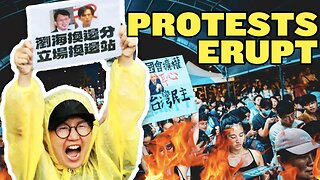The Third Truth About 9/11 by Dimitri Khalezov - Part 9 of 26
Part 09. Discussion about the actual physical processes of an underground nuclear
explosion continues followed by animated graphical illustrations. Khalezov explains also
that rock from the so-called “crushed zone” could retain for a while its original color and
shape. If you very carefully pick up a stone from that area it looks like it was before the
nuclear explosion - the same shape and the same color. However, when you press it even
slightly with your fingers it will instantly turn to complete microscopic dust. Khalezov
repeats that people standing on the earth’s surface can not be injured by the third
destructive factor of a nuclear explosion - i.e. by its ionizing penetrating radiation,
because it will be absorbed by surrounding areas of the rock and can not reach the earth’s
surface. However, it does not mean that you can stand above such a spot of a recent
underground nuclear explosion. The problem is that highly-radioactive gases that are
under high pressure inside the cavity eventually will find their way out and will reach the
earth’s surface via some crevices in the rock. Therefore people on the surface could still
get some radiation injury by these radioactive gases which represent in this case the
destructive factor No.4 (radioactive contamination). That is why, according to Khalezov,
the United States and the Soviet Union carried out their underground nuclear testing only
in remote areas. However, according to him, a layer of soil that lays between the upper
end of the underground cavity and the earth’s surface will act in this case like a filter. The
thicker the filter, the less radioactivity will be carried up to the earth’s surface and into its
atmosphere. For 150 kiloton nuclear explosion detonated in granite rock a “safe” depth
will be 500 meters deep underground, because in this case there would be at least 400
meters of remaining rock on top of the cavity to act as a filter. But even in such a case it
would be prohibited for people to stay about the spot of such a deep underground nuclear
explosion for at least 2 weeks - i.e. during time the radioactive gases are finding their
way into the atmosphere. But when it comes to visiting an actual hypocenter of a nuclear
explosion (i.e. a cavity left by such a 150 kiloton nuclear charge) it is impossible to go
there until at least 3 years have passed, because it is deadly radioactive and also
extremely hot inside. Asked how long it would keep heat, Khalezov answers that it would
stay hot for at least 1 year. Asked about the actual demolition arrangement of the WTC
he answers that 500 meters “safe” distance for detonating of a 150 kiloton nuclear charge
in granite rock was applicable to a typical nuclear test, not to a specific demolition task.
In the case of the WTC demolition charges were positioned not too deep. The explanation
is followed by a graphical scheme where it is shown that an underground part of each
Twin Tower was 27 meters below ground level. The nuclear charges were positioned
another 50 meters below that point (or 77 meters below the surface level). In this case
their explosion would create a cavity of 50 meters radius, so that he upper end of the
cavity would reach exactly the lowest underground foundations of the Tower, but would
not reach the earth’s surface.
Here is a link to a zip-file with Dimitri's deposition in book-form and important related files: https://archive.org/download/the-third-truth-about-9-11-interview/911thology.zip
Part 10: https://rumble.com/v2o0xvq-the-third-truth-about-911-part-10-of-26.html
-
 9:32
9:32
China Uncensored
13 hours agoBad Things Are Happening In Taiwan...
16.9K17 -
 38:24
38:24
Tucker Carlson
10 hours agoTucker Carlson and Donald Trump Jr. Respond to the Trump Verdict
95.6K521 -
 2:01:47
2:01:47
Fresh and Fit
10 hours agoOne Hit Wonder 🤡 Kicked Off For THIS...
171K370 -
 34:19
34:19
Alexis Wilkins
17 hours agoBetween the Headlines with Alexis Wilkins: The Verdict and More
45.5K30 -
 1:11:21
1:11:21
Kim Iversen
16 hours agoWW3?!? Is The West Secretly Behind Another Color Revolution Aimed At Toppling Russia? | Biden Maniacally Bombs Yemen and Russia
90.9K87 -
 1:36:46
1:36:46
Roseanne Barr
14 hours agoFor Love of Country with Tulsi Gabbard | The Roseanne Barr Podcast #50
100K172 -
 33:59
33:59
TudorDixon
21 hours agoA Story of Sacrifice and Service with Joe Kent | The Tudor Dixon Podcast
37K4 -
 27:22
27:22
The Nima Yamini Show
13 hours agoAlpha Nima Crushes Nick Fuentes & Business Tips with Dylan
35K20 -
 1:19:23
1:19:23
Mally_Mouse
12 hours agoLet's Hang - Cosplay Stream!!
52.7K2 -
 1:05:06
1:05:06
Lou Dobbs
19 hours agoLou Dobbs Tonight 5-31-2024
68.4K43